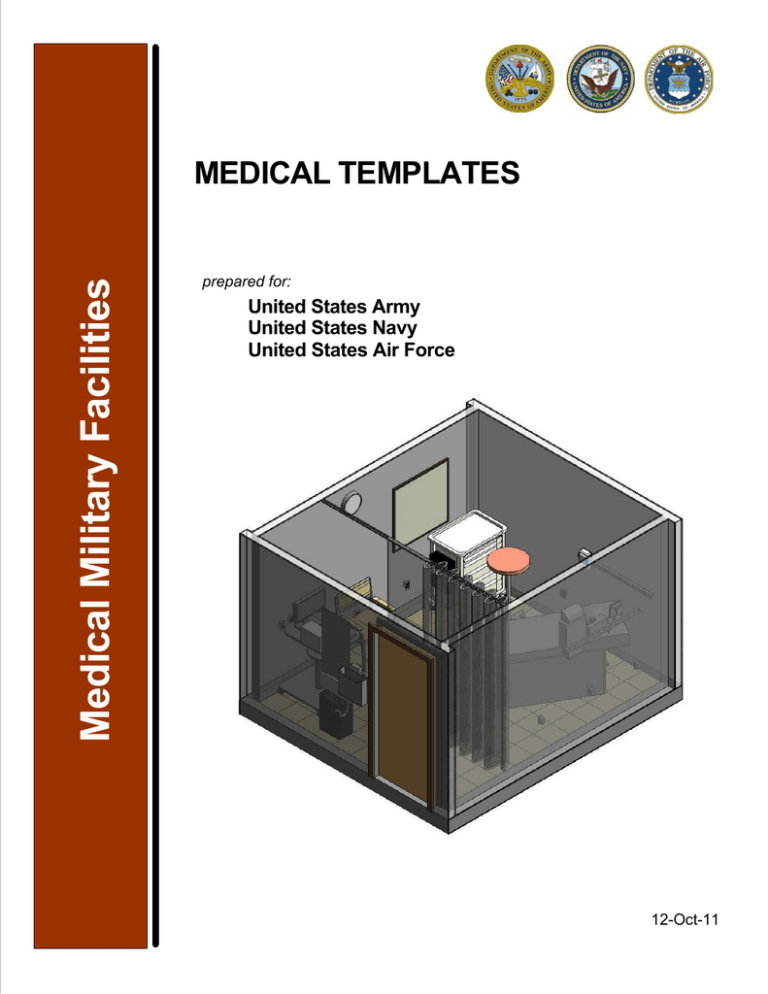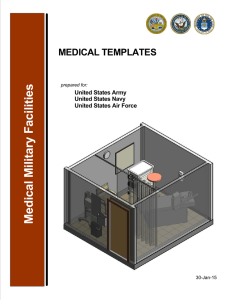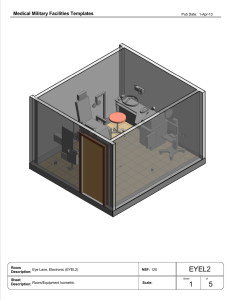Medical Military Facilities MEDICAL TEMPLATES United States Army United States Navy
advertisement

Medical Military Facilities MEDICAL TEMPLATES prepared for: United States Army United States Navy United States Air Force 12-Oct-11 Medical Military Facilities Templates Pub Date: 12-Oct-11 GENERAL INFORMATION Purpose The purpose of this document is to supplement UFC 4-510-01 in providing detailed design guidance for Medical Military Facilities. Use the latest version of UFC 4-510-01 as the primary design criteria when developing medical related facilities or rooms. References UFC 4-510-01 "Design: Medical Military Facilities" Template Grouping Information provided in this document is grouped under the following areas. For a complete index of Templates, refer to Appendix C. • General Design Information • Administration, Logistics, Common Areas • Nursing Units, Surgery, Obstetrics, Patient Services Areas • Occupational And Physical Therapy Areas • Outpatient (Dental) Areas • Outpatient (Medical) Areas • Pathology Areas • Pharmacy Areas • Radiology, Radiation Therapy, Nuclear Medicine Areas • Appendix A - Architectural and Engineering Design Requirements • Appendix B - Equipment Details • Appendix C - Index Architectural and Engineering Design Requirements Refer to Appendix A to view detailed room-by-room design requirements such as material/wall finishes, ceiling heights, noise requirements, floor loads, lighting requirements, HVAC requirements, and medical gas requirements. Equipment Details Refer to Appendix B to view detailed equipment information. Revisions Refer to Appendix C to view a listing/description of the latest Template revisions. Room Description: NSF: Plate Description: General Information Scale: Sheet 1 of 4 Medical Military Facilities Templates Pub Date: 12-Oct-11 GENERAL INFORMATION Supplemental Design Criteria The following is a list of pertinent design information that is not indicated on the Templates but instead is defined in UFC 4-510-01. Architectural: • • • • Ceiling Heights Door Sizes Acoustic Noise Levels Finish Materials Electrical/Communications: • • • • • • Light Levels (Lux and Footcandles) Types of Light Fixtures Dimming Requirements Switching Requirements Telephone Equipment Requirements Emergency Power Requirements Mechanical: • • • • • • • Air Balance Air Changes Interior Design Temperature Relative Humidity Requirements Filtration Levels Exhaust Requirements Plumbing and Medical Gases Structural: • Floor Loading UFAS/ADA Interpretations: • UPAS/ADA Interpretations and Waivers Universal X-Ray Room: • • • • • • • • • Power Electrical Raceways Floor Ducts Wall Ducts Ceiling Cable Trays Partitions Shielding Ceiling Support Casework Note: The universal X-ray room is defined as capable of accepting all routine radiographic, fluoroscopic and tomographic equipment. Floor/Equipment Plans "Notes" apply where specifically referenced by number in the drawing. Stud Partitions All partitions that have wall mounted equipment or casework must be designed to ensure that the metal studs have adequate size, gauge and spacing to properly support these loads. Provide mounting or backing plates where needed. Sinks and Base Cabinets When designing sinks, sink base cabinets and counters, based on JSN items, carefully coordinate actual sink depths with the actual clear sink cabinet openings, noting that JSN descriptions may list nominal dimensions and that these dimensions will also vary from one manufacturer to another. The AE has the option to specify sinks with 18" outside depths to fit in the standard JSN sink cabinet that is 2" in total out to out dimensions. A 22" deep cabinet is often only 21-5/8" deep. This depth often includes a 3/4" cabinet face and a 3/4" back face, making the actual clear depth about 20-1/8". When the back portion of the sink basin that holds the plumbing fixture is excluded (approximately (4-1/2"), there is usually a 15-5/8" depth remaining for the actual sink. Room Description: NSF: Plate Description: General Information Scale: Sheet 2 of 4 Medical Military Facilities Templates Pub Date: 12-Oct-11 GENERAL INFORMATION Hands Free Lavatories When designing lavatories, the designer should verify with the user between a JSN P3100, Lavatory, and a JSN P3200, Lavatory Electronic. The JSN P3100, Lavatory, which has a manual faucet, is typically shown on the guide plates; however, a JSN P3200, Lavatory Electronic, which is an electronic hands free faucet, can be substituted when requested. Handicap Accessible Lavatories Lavatories should typically be designed for handicap access and comply with the most recent codes and federal regulations, which include clearances, mounting heights and insulating exposed hot water piping. Refer to Templates "Typical Equipment Mounting Heights" for more information. Lighting, Lighting Controls and Lighting Levels Lighting fixtures shown on the reflected ceiling plans for each Template are for reference only, and serve as only one possible design solution. Since conditions vary for each specific building design, the locations, size, lamp types and quantities need to be verified by the lighting designer. Lighting calculations are required and must be based on lighting level criteria listed in the latest edition of the UFC 4-510-01. Lighting criteria, types of lighting fixtures, dimming requirements, switching requirements, and emergency power requirements are listed in the UFC 4-510-01. Electrical and Communications Outlets Electrical and communications outlets are shown on the floor plans for each Template. They serve only as one possible design solution. Since conditions vary for each specific building design, the locations, and mounting heights for all outlets and devices must be verified by the designer. Communication outlets are indicated; the designer should refer to UFC 4-510-01 and MILHDBK-1691 and specific user requirements for the type of telephone set that will be used. Emergency Power and Battery Back-Up Systems Typically, emergency power and battery back-up systems are not shown on these Templates. Requirements should be based on criteria listed in the latest edition of the UFC 4-510-01. Emergency power outlets only apply with facilities with emergency power. HVAC AC Diffusers and Radiators Supply and return air diffusers (and thermostats and radiators on the floor plans) are shown on the reflected ceiling plans for each Template. The location of all these items serve as only one possible design solution. Since conditions vary for each specific building design, the locations, number, size and diffuser type need to be verified by the HVAC designer for each actual design. HVAC calculations are required and should be based on criteria listed in the latest edition of the UFC 4510-01. Criteria for air balance, air changes, interior design temperatures, relative humidity requirements, filtration levels, and exhaust requirements are listed. If multiple ceiling diffusers or registers are indicated, the designer may vary the quantity based on the actual load conditions. Room Description: NSF: Plate Description: General Information Scale: Sheet 3 of 4 Medical Military Facilities Templates Pub Date: 12-Oct-11 GENERAL INFORMATION Medical Gas Outlets Refer to Templates "Medical Gas Outlet Schedule". Medical gas outlets indicated on the schedule are the maximum required as per UFC 4-510-01. Verify medical gas outlet arrangement and count with the user. The Templates also indicate the maximum medical gas outlets per UFC 4-510-01. Eyewash/Emergency Showers Water discharged from eyewashes/emergency showers shall be limited to a temperature between 15 35 degrees C (60 - 95 degrees F). If a facility's water service annual temperature profile can be shown to be in the specified range, then no tempering of the water is required. If tempering of water is required, provide a JSN P2450, thermostatic mixing valve to eyewash and emergency shower units. Mixing valves shall be located above the ceiling near appliance served. Lockable Cabinets Locking capability is required on all cabinets. The use of locks should be verified at each MTF. Locks are extremely important at all treatment spaces (i.e. ER, Outpatient, Orthopedics, etc.) that have medicine cabinets outside the curtained area. OCONUS Projects Projects outside the continental United States may have different life safety, building code, day lighting and utility requirements and may need to be re-evaluated. Thermostat Thermostat needs to be located at the most non-invasive wall location within a room. Garment Hook JSN A5145, Hook, Garment, Double, SS, Surface Mounted, shall be mounted at 4'-0" AFF, on the back of the door, to meet the ABA mounting height standard. Telecommunications Outlet All rooms shall have, at minimum, 2 telecommunication outlets. Chart Holder Coordinate the location of JSN M1620, Holder, Chart, Patient, Wall or Door Mounted, with the room signage. Room Description: NSF: Plate Description: General Information Scale: Sheet 4 of 4

